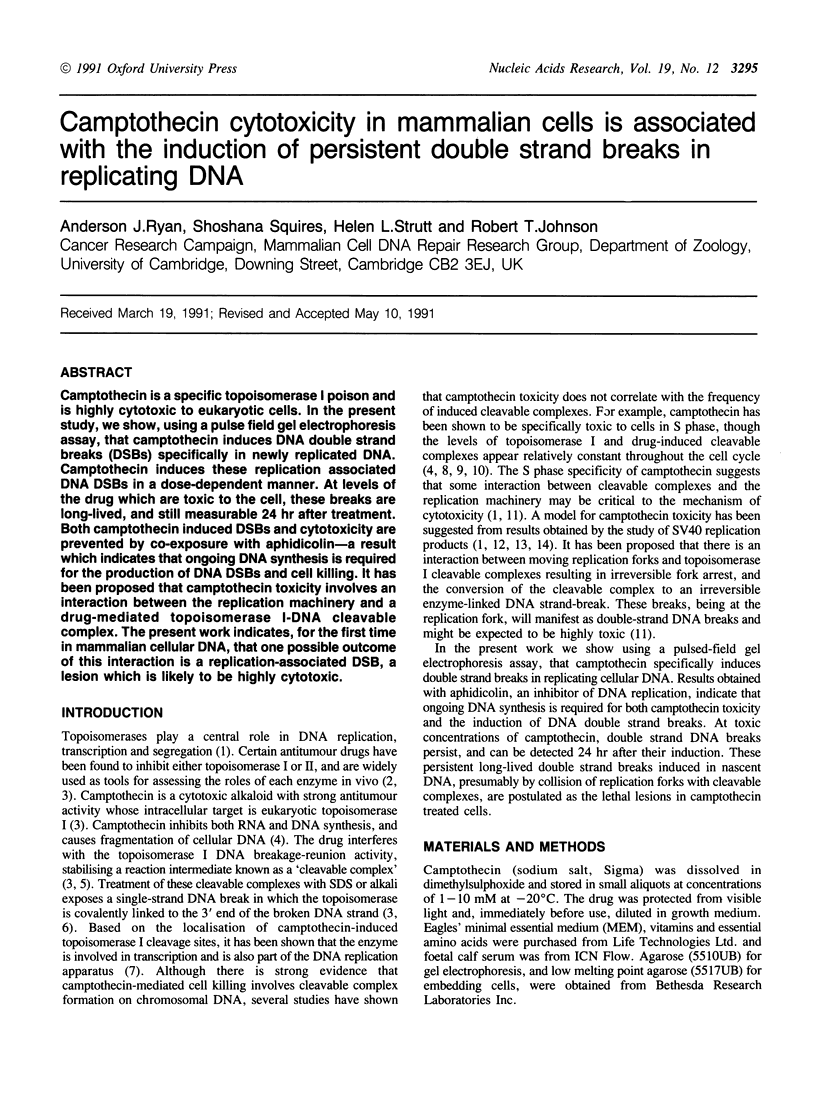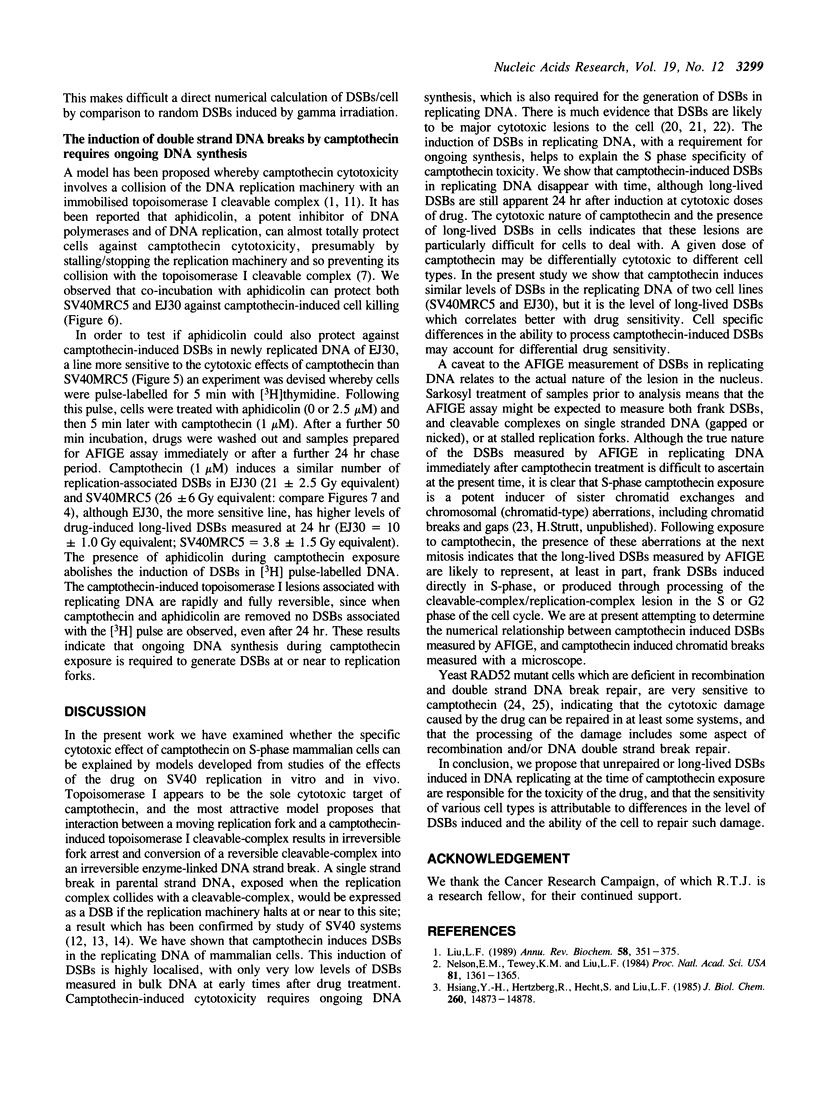Abstract
Camptothecin is a specific topoisomerase I poison and is highly cytotoxic to eukaryotic cells. In the present study, we show, using a pulse field gel electrophoresis assay, that camptothecin induces DNA double strand breaks (DSBs) specifically in newly replicated DNA. Camptothecin induces these replication associated DNA DSBs in a dose-dependent manner. At levels of the drug which are toxic to the cell, these breaks are long-lived, and still measurable 24 hr after treatment. Both camptothecin induced DSBs and cytotoxicity are prevented by co-exposure with aphidicolin--a result which indicates that ongoing DNA synthesis is required for the production of DNA DSBs and cell killing. It has been proposed that camptothecin toxicity involves an interaction between the replication machinery and a drug-mediated topoisomerase I-DNA cleavable complex. The present work indicates, for the first time in mammalian cellular DNA, that one possible outcome of this interaction is a replication-associated DSB, a lesion which is likely to be highly cytotoxic.
Full text
PDF





Selected References
These references are in PubMed. This may not be the complete list of references from this article.
- Ager D. D., Dewey W. C. Calibration of pulsed field gel electrophoresis for measurement of DNA double-strand breaks. Int J Radiat Biol. 1990 Aug;58(2):249–259. doi: 10.1080/09553009014551601. [DOI] [PubMed] [Google Scholar]
- Avemann K., Knippers R., Koller T., Sogo J. M. Camptothecin, a specific inhibitor of type I DNA topoisomerase, induces DNA breakage at replication forks. Mol Cell Biol. 1988 Aug;8(8):3026–3034. doi: 10.1128/mcb.8.8.3026. [DOI] [PMC free article] [PubMed] [Google Scholar]
- Covey J. M., Jaxel C., Kohn K. W., Pommier Y. Protein-linked DNA strand breaks induced in mammalian cells by camptothecin, an inhibitor of topoisomerase I. Cancer Res. 1989 Sep 15;49(18):5016–5022. [PubMed] [Google Scholar]
- D'Arpa P., Beardmore C., Liu L. F. Involvement of nucleic acid synthesis in cell killing mechanisms of topoisomerase poisons. Cancer Res. 1990 Nov 1;50(21):6919–6924. [PubMed] [Google Scholar]
- Degrassi F., De Salvia R., Tanzarella C., Palitti F. Induction of chromosomal aberrations and SCE by camptothecin, an inhibitor of mammalian topoisomerase I. Mutat Res. 1989 Mar;211(1):125–130. doi: 10.1016/0027-5107(89)90112-7. [DOI] [PubMed] [Google Scholar]
- Denko N., Giaccia A., Peters B., Stamato T. D. An asymmetric field inversion gel electrophoresis method for the separation of large DNA molecules. Anal Biochem. 1989 Apr;178(1):172–176. doi: 10.1016/0003-2697(89)90375-8. [DOI] [PubMed] [Google Scholar]
- Eng W. K., Faucette L., Johnson R. K., Sternglanz R. Evidence that DNA topoisomerase I is necessary for the cytotoxic effects of camptothecin. Mol Pharmacol. 1988 Dec;34(6):755–760. [PubMed] [Google Scholar]
- Frankenberg D., Frankenberg-Schwager M., Blöcher D., Harbich R. Evidence for DNA double-strand breaks as the critical lesions in yeast cells irradiated with sparsely or densely ionizing radiation under oxic or anoxic conditions. Radiat Res. 1981 Dec;88(3):524–532. [PubMed] [Google Scholar]
- Heck M. M., Hittelman W. N., Earnshaw W. C. Differential expression of DNA topoisomerases I and II during the eukaryotic cell cycle. Proc Natl Acad Sci U S A. 1988 Feb;85(4):1086–1090. doi: 10.1073/pnas.85.4.1086. [DOI] [PMC free article] [PubMed] [Google Scholar]
- Horwitz M. S., Horwitz S. B. Intracellular degradation of HeLa and adenovirus type 2 DNA induced by camptothecin. Biochem Biophys Res Commun. 1971 Nov 5;45(3):723–727. doi: 10.1016/0006-291x(71)90476-1. [DOI] [PubMed] [Google Scholar]
- Hsiang Y. H., Hertzberg R., Hecht S., Liu L. F. Camptothecin induces protein-linked DNA breaks via mammalian DNA topoisomerase I. J Biol Chem. 1985 Nov 25;260(27):14873–14878. [PubMed] [Google Scholar]
- Hsiang Y. H., Lihou M. G., Liu L. F. Arrest of replication forks by drug-stabilized topoisomerase I-DNA cleavable complexes as a mechanism of cell killing by camptothecin. Cancer Res. 1989 Sep 15;49(18):5077–5082. [PubMed] [Google Scholar]
- Hsiang Y. H., Liu L. F. Identification of mammalian DNA topoisomerase I as an intracellular target of the anticancer drug camptothecin. Cancer Res. 1988 Apr 1;48(7):1722–1726. [PubMed] [Google Scholar]
- Jeggo P. A., Kemp L. M. X-ray-sensitive mutants of Chinese hamster ovary cell line. Isolation and cross-sensitivity to other DNA-damaging agents. Mutat Res. 1983 Dec;112(6):313–327. doi: 10.1016/0167-8817(83)90026-3. [DOI] [PubMed] [Google Scholar]
- Kessel D., Bosmann H. B., Lohr K. Camptothecin effects on DNA synthesis in murine leukemia cells. Biochim Biophys Acta. 1972 May 10;269(2):210–216. doi: 10.1016/0005-2787(72)90429-7. [DOI] [PubMed] [Google Scholar]
- Li L. H., Fraser T. J., Olin E. J., Bhuyan B. K. Action of camptothecin on mammalian cells in culture. Cancer Res. 1972 Dec;32(12):2643–2650. [PubMed] [Google Scholar]
- Liu L. F. DNA topoisomerase poisons as antitumor drugs. Annu Rev Biochem. 1989;58:351–375. doi: 10.1146/annurev.bi.58.070189.002031. [DOI] [PubMed] [Google Scholar]
- Nelson E. M., Tewey K. M., Liu L. F. Mechanism of antitumor drug action: poisoning of mammalian DNA topoisomerase II on DNA by 4'-(9-acridinylamino)-methanesulfon-m-anisidide. Proc Natl Acad Sci U S A. 1984 Mar;81(5):1361–1365. doi: 10.1073/pnas.81.5.1361. [DOI] [PMC free article] [PubMed] [Google Scholar]
- Nitiss J., Wang J. C. DNA topoisomerase-targeting antitumor drugs can be studied in yeast. Proc Natl Acad Sci U S A. 1988 Oct;85(20):7501–7505. doi: 10.1073/pnas.85.20.7501. [DOI] [PMC free article] [PubMed] [Google Scholar]
- Resnick M. A., Martin P. The repair of double-strand breaks in the nuclear DNA of Saccharomyces cerevisiae and its genetic control. Mol Gen Genet. 1976 Jan 16;143(2):119–129. doi: 10.1007/BF00266917. [DOI] [PubMed] [Google Scholar]
- Shibuya M. L., Buddenbaum W. E., Don A. L., Utsumi H., Suciu D., Kosaka T., Elkind M. M. Amsacrine-induced lesions in DNA and their modulation by novobiocin and 2,4-dinitrophenol. Cancer Res. 1991 Jan 15;51(2):573–580. [PubMed] [Google Scholar]
- Shin C. G., Snapka R. M. Exposure to camptothecin breaks leading and lagging strand simian virus 40 DNA replication forks. Biochem Biophys Res Commun. 1990 Apr 16;168(1):135–140. doi: 10.1016/0006-291x(90)91684-k. [DOI] [PubMed] [Google Scholar]
- Snapka R. M. Topoisomerase inhibitors can selectively interfere with different stages of simian virus 40 DNA replication. Mol Cell Biol. 1986 Dec;6(12):4221–4227. doi: 10.1128/mcb.6.12.4221. [DOI] [PMC free article] [PubMed] [Google Scholar]
- Stamato T. D., Denko N. Asymmetric field inversion gel electrophoresis: a new method for detecting DNA double-strand breaks in mammalian cells. Radiat Res. 1990 Feb;121(2):196–205. [PubMed] [Google Scholar]


